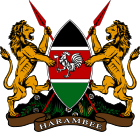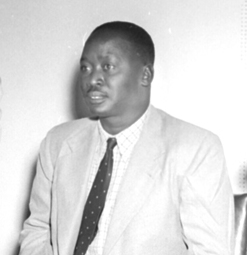 |
|---|
|
Economic schemes |
The Kenya National Party (KNP) was a political party in Kenya.
 |
|---|
The Kenya National Party (KNP) was a political party in Kenya.
The KNP was established in July 1959 as a multiracial party consisting of African, Arab, European and Indian members of the Legislative Council, led by Masinde Muliro. [1] Several prominent politicians joined the party, including Daniel arap Moi, Ronald Ngala and Taaitta Toweett. [2] Its members were opposed to the overbearing behaviour of Tom Mboya, who set up the Kenya Independence Movement (KIM) in response to the KNP's formation. [2]
However, by November 1959 the party was no longer multiracial, and by the end of the year, had joined with the KIM to present a united front at the Lancaster House Conference. [2] After the conference the KNP was briefly relaunched as the Kenya African People's Party (KAPP) before merging with several other parties in June 1960 to form the Kenya African Democratic Union, [2] whilst the KIM merged into the rival Kenya African National Union.

The Kenya African Democratic Union (KADU) was a political party in Kenya. It was founded in 1960 when several leading politicians refused to join Jomo Kenyatta's Kenya African National Union (KANU). It was led by Ronald Ngala who was joined by Moi's Kalenjin Political Alliance, the Masai United Front, the Kenya African Peoples Party, the Coast African Political Union, Masinde Muliro's Baluhya Political Union and the Somali National Front. The separate tribal organisations were to retain their identity and so, from the very start, KADU based its political approach on tribalism. KADU's aim was to defend the interests of the so-called KAMATUSA as well as the British settlers, against the imagined future dominance of the larger Luo and Kikuyu that comprised the majority of KANU's membership, when it became inevitable that Kenya will achieve its independence. The KADU objective was to work towards a multiracial self government within the existing colonial political system. After release of Jomo Kenyatta, KADU was becoming increasingly popular with European settlers and, on the whole, repudiated Kenyatta's leadership. KADU's plan at Lancaster meetings was devised by European supporters, essentially to protect prevailing British settlers land rights.

Jaramogi Ajuma Oginga Odinga was a Kenyan politician who became a prominent figure in Kenya's struggle for independence. He served as Kenya's first vice-president, and thereafter as opposition leader. Odinga's son Raila Odinga is a former prime minister, and another son, Oburu Odinga, is a former assistant minister in the Ministry of Finance.

The Kenya African Union (KAU) was a political organization in colonial Kenya, formed in October 1944 prior to the appointment of the first African to sit in the Legislative Council. In 1960 it became the current Kenya African National Union (KANU).
Pio Gama Pinto was a Kenyan journalist, politician and freedom fighter. He was a socialist leader who was key in Kenya's struggle for independence. He was assassinated in 1965, leading many to consider him independent Kenya's first political martyr.

General elections were held in Kenya in February 1961. The result was a victory for the Kenya African National Union, which won 19 of the 53 elected seats.

A series of by-elections were held in Kenya on 11 and 12 June 1966, becoming known as the "little general election". They followed the defection of 29 members of the Kenya African National Union (KANU) to establish the Kenya People's Union. As a result, the KANU government passed a constitutional amendment to force the MPs to seek re-election. Although the KPU received the most votes in the by-elections, KANU won more seats.

The New Kenya Party was a political party in Kenya.

The Kenya Indian Congress (KIC) was a political party in Kenya.
Sir Michael Blundell was a Kenyan farmer and politician who served as a member of the Legislative Council from 1948 until 1963, and as Minister of Agriculture in two spells between 1955 and 1962.

The Kenya Coalition was a political party in Kenya.

The United Country Party was a political party in Kenya.

The Kenya Freedom Party (KFP) was a political party in Kenya.

The African People's Party (APP) was a political party in Kenya.

The Party of Independent Candidates of Kenya (PICK) is a political party in Kenya.

The Kenya Social Congress (KSC) is a political party in Kenya. Its symbol is a broom. The party is currently led by Samson Atati Kengere, with Dennis Anyoka as deputy leader.

The Kenya National Democratic Alliance (KENDA) is a political party in Kenya.

The United Party was a political party in Kenya.

The Kenya Independence Movement (KIM) was a political party in Kenya.

The Legislative Council of Kenya (LegCo) was the legislature of Kenya between 1907 and 1963. It was modelled on the Westminster system. It began as a nominated, exclusively European institution and evolved into an elected legislature with universal suffrage. It was succeeded by the National Assembly in 1963.
The Nairobi People's Convention Party (NPCP) was a Nairobi based political party formed in 1957 by Tom Mboya. This party played a crucial role in the fight for Kenya's independence. Despite attempts at suppression from the colonial government, the NPCP managed to mobilise Africans in Nairobi to further the nationalist cause and fight for independence from Britain. Following Jomo Kenyatta's release from detention in 1961, the NPCP merged with the Kenya African Union (KAU) and Kenya Independence Movement (KIM) to form the Kenya African National Union (KANU).